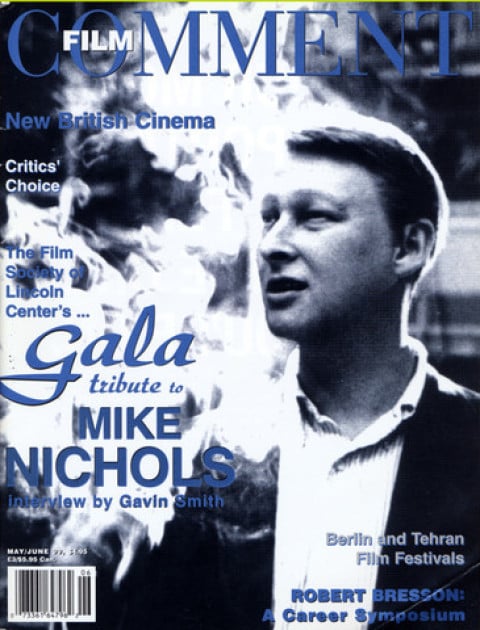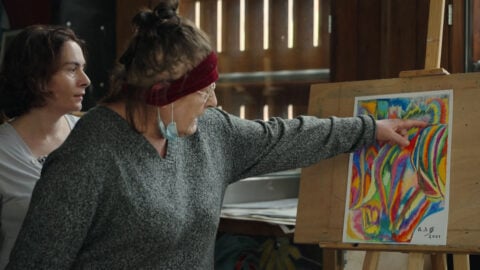
A serene middle-aged man sits down at what is apparently a rolltop desk. Around him, shallow darkness, and the arms and torso of an assistant standing by his side. The man pulls up the rolltop (the sound of wood sliding over wood) to reveal a pipe organ. He plays a single, resounding note as he pulls out the stops. A cut, to four teenagers walking up a set of stone stairs (the sound of their footsteps). Their eyes are cast down, their arms are dangling at their sides, their postures are stooped and heavy, their clothes rumpled and colorless. Eye-level on them and a few more teenagers as they walk through a doorway (a change in tone—the room they’re entering has an echo). A long view of the mighty pipes of the organ under stained glass windows—we’re in a church (two blasts from the organ, a troubling sound—unlucky chance that these particular notes fall together). An angle on a group of empty wooden chairs on a dark floor (a high note—nervous pitch of expectancy). The four teenagers take seats in the foreground. As they look up at an unseen speaker, we see from their faces that they are defiantly expecting a definitive word from someone, somewhere. That, after all, is why they’re here.
The precise coordination of every element of filmmaking—camera distance, sound, theme, narrative, motion, color, human action—so that it functions with a perfect rhythmic clarity: that is the cinema of Robert Bresson. Bresson’s aim is to sound out the profound mysteries that lurk within the spaces between objects, actions, and emotions, and the fact that he’s been so uncommonly good at it for so long is attributable to his profound sense of harmony between images and sounds.
No one has ever made films that are at once so concentrated and so expansive, so precise in their mapping of action and so careful to allow for a resonance beyond the imagination of almost everyone else who has ever worked in the medium. No other filmmaker has followed everyday existence with such patience, care, and love. The tension between what is seen and what is felt, what is understood and what is undefinable yet present, lies at the core of Bresson’s work. “O’erstep not the modesty of nature,” Hamlet demanded of the Players. The balance between an object and its filmic representation feels absolutely just in Bresson. He works painstakingly so that his films appear to register and acknowledge all things equally: a bouquet of daisies thrown on an asphalt road becomes just as moving as the face of a man behind bars at long last acknowledging his love for the woman on the other side. And aren’t human beings the most elusive objects of all? Here is an artist who understands the difference between how we present ourselves and what we give away about ourselves without knowing it.
Many people imagine Bresson as some kind of infallible, divinely inspired artist, one who strikes fear in the hearts of critics and fellow filmmakers. His reclusive nature and the oracular tone of his pronouncements on the cinema only add to the severity of the image. His filmmaking, so far outside of the norm, has encouraged nothing but extremes. How often have the words “transcendental” and “austere” been used to describe his work? Do they help us to appreciate and understand Au hasard, Balthazar or Lancelot du Lac? It’s important to remember that the section on Bresson in Paul Schrader’s brilliant and enormously influential Transcendental Style in Film deals exclusively with four films. Schrader makes it clear that the films before and after the “prison quartet” fall beyond the limits of his inquiry. In a general discussion of Bresson’s work, I think that the word “austere” tells us more about what his films aren’t and what they deny themselves than what they are and what they actually consist of. The word “transcendental” is even more questionable. Through overuse, its meaning has evolved from something specific, in Schrader’s book, to something vague. Bresson is probably more deserving of extravagant praise than any other living filmmaker, but is it proper to say that every film he’s ever made falls under the heading of “transcendental”? It sidesteps the question of artistic evolution (the journey from Affaires publiques to L’Argent is much richer and more varied than has often been imagined) and strips the films of their individuality. And it also shortchanges the later work in particular, where the question of belief becomes profoundly problematic.
I think that the very unusual tools and constraints that Bresson has allowed himself as a filmmaker—shallow space (he always uses a 50mm lens), nonacting, an emphatic use of sound—have riveted the attention at the expense of the films themselves, thus making his body of work appear more uniformly ascetic than it actually is. Perhaps we have finally arrived at the moment when we can get beyond the plain physical shock of his filmmaking, and forget the fact that his “models” are not acting in order concentrate on their individual self-revelations. Perhaps we can stop measuring his idiosyncrasies and start seeing the evolution in his work. In the Sixties, Bresson became increasingly interested in the particulars of the modern world, and by the Seventies he had turned away from dramas of individual regeneration and redemption and become a chronicler of the present. There is a terrific moral urgency to this shift: it’s as though he was profoundly affected by the feelings of defeat and lethargy in the young people around him, and decided to devote himself to giving those feelings a voice, and to describing their parameters. In his last two fiercely concentrated films, The Devil Probably and L’Argent, Bresson drifted to the edge of his “Christian universe” and measured the void beyond on behalf of his defeated protagonists. Those last works are like nothing else in modern cinema, as horrifying as they are lucid, as sure of the inherent beauty of the world as they are insistent on the recognition of its manmade horror.
For all his complaints about the theatricality that has infected the cinema, for all his insistence that his own work remain separate from everyone else’s, we have to see Bresson in the end as a member of the community of cinema, whose solitude allowed him to operate at its highest level. What other filmmaker has given us as much of the world? Who has defined the physical fact of people so carefully, of the human body’s contracting and shuddering when it comes in contact with reality? Think of Fontaine and Jost crouching expectantly in A Man Escaped, of the Pickpocket standing at the racetrack and reaching into the pocketbook, of the old woman cleaning up the broken wine glass in L’Argent. More than any other filmmaker, his work is tuned to all facets of experience—chance, the sensual, the moral, the natural, the psychological, the manmade, the metaphysical—and the film is carefully aligned so that they are all sounded. All the time spent pondering his “inaccessibility” has been wasted. Just as it is in Rothko’s paintings or Webern’s music, the emotion in Bresson’s small but magnificent oeuvre is there for those with eyes to see it and ears to hear it.








